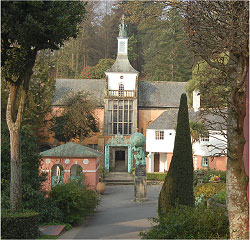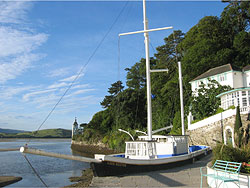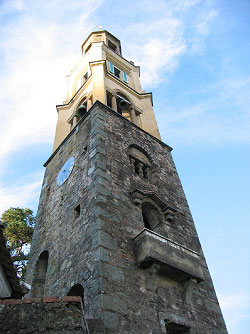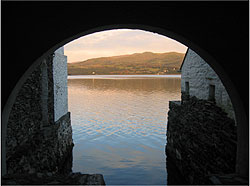About the Village of Portmeirion, Wales
From the author’s eccentric guidebook, Puzzling Portmeirion:
Virtual reality for the masses? It’s already here, and you don’t need a high-tech headset, goggles, or gloves. It’s at Portmeirion, where reality and illusion are indistinguishable. But don’t be fooled by glossy brochures: Portmeirion is no candy-colored utopian community. It’s more like an elaborate contraption from a bizarre science fiction novel, manipulating its visitors in undreamt-of ways. As with a video game, if you have a grasp of how things operate, you can play along and increase your level of fun.
Portmeirion opened to the public in 1926 (nearly 30 years before Disneyland) and was experimenting with virtual reality decades before the term was coined. Columnist Nicholas De Jongh writes that “to see the place is like traveling into someone else’s vision.”1 Portmeirion was “built by someone who never left childhood completely. It’s a world which the subconscious would know and recognize as invented rather than seen.”

A town hall serving no citizenry |
The mother of all themed environments sends you tumbling mind, body, and spirit into the heart of invention. Consider:
- You find yourself standing in front of a town hall, yet this is a village with no residents, only guests.
- Phony picture windows are meant to be looked at, not looked through.
- The town square is surrounded by bright, Italianate pavilions, seemingly having gotten “lost in a storm and accidentally land[ing] on the shores of the Atlantic Ocean as opposed to their familiar Mediterranean Sea.”2
- The buildings’ vibrant colors (white, green turquoise, ochre, terracotta, yellow, orange, cobalt blue, and pink) are “thoroughly disorienting.”3
- “Space ebbs and flows like water into small pools and dramatic, open cascades.”1 Individual buildings are in fact jumbles of salvaged materials from all over Europe.
- With the warping of space, time itself is twisted: buildings from different historical periods stand side by side, while plaques on statues memorialize not single years but multiple centuries at once.
- “On a clear day . . . one is captured in a 360 degree sensurround screen of architectural fantasy, sea, sunshine, sand and, occasionally, snow on the surrounding peaks.”5

The Amis Reunis is a boat-shaped retaining wall below the main hotel building. |
- It’s a port, yet the estuary is so shallow that only the occasional dinghy can approach.
- There’s a lighthouse on a rocky promontory, but no light.
- There’s a boat on the harbor, but it’s permanently anchored because it is in fact a building made of stone (complete with slate floor), serving as a retaining wall.
People can’t even agree on how “substantial” the village is. Travel critic Jan Morris calls it “a floating fantasy above the sea . . . the whole thing . . . clustered with an airy flimsiness on its steep slope, as though one day it might slide all on top of itself into the water.”6 In direct contradiction, Country Life says that “At Portmeirion the buildings almost literally grew out of the rock and were intended to look as if they did.”7

A “forced perspective” architectural technique makes buildings such as the Campanile and Bridge House seem taller. |
Ramshackle or sturdy? Exotic or traditional? Practical or whimsical? Cluttered or immaculate? The virtual reality of Portmeirion defies easy categorization. In this topsy-turvy world, petrol pumps are ornaments, gilded Burmese dancers stand atop Ionic columns, and a giant Buddha sits under a pantiled loggia. “Portmeirion is in turns foreign and then strangely familiar, beautiful but not in an ordinary kind of way.”8 Around every corner, Clough’s magic wand manipulates our perceptions to create a wholly artificial reality. The remarkable thing is that most of the tricks are subliminal. Architectural sleights such as forced perspective and gradiented paint make buildings seem taller—or smaller—than they really are. For instance, the height of the Campanile has been so exaggerated that the top is actually only one-half size. The walls of the Gate House cottage feature three different shades of paint, lightest at the top and darkest below. Oversized chimneys, extremely low arches, reduced upper stories, and small statues also create illusions of height and distance.9 Such manipulation makes a building more welcoming and accessible. According to Clough, “Portmeirion is . . . very definitely scaled down, and if not strictly ‘miniature’ is none the less rather cozily compact and intimate.”

Views are deliberately framed by archways. |
Who could keep track of Portmeirion’s total control of your environment? In designing his village, Clough avoided symmetry in order to achieve movement, deliberately accenting a sudden elevation in landscape, for example, so that your eye is forced to keep moving up. Everywhere you look, views are deliberately framed by archways, doorways, and sculpted vegetation.
However, lest visitors wander about like puppets, expectations are dashed at every opportunity—buildings with towers or battlements aren’t fortresses, for example, nor do pinnacles or flying buttresses signify a church. Stately columns may not support much of anything, and ornate doorways likely lead to nowhere. The entire village is “rich in the unexpected: odd angles, surprising little balconies, curious juxtapositions.”10 The grand design is meant to be a feast for the mind as well as the eyes. The visitor is meant to think outside the box, to get lost in another dimension, to stumble upon spontaneous drama, to fire forgotten synapses hidden in the recesses of the brain, to discover the missing pieces of a seemingly finished puzzle.

This mermaid statue is actually a painting on sheet metal—an illusion which invites close inspection. |
Interestingly, the follies of Portmeirion are boldly presented, without apology. The trompe l’oeils at every turn are effective, but don’t fool so much as intrigue. Clough not only produces illusion but—in confessing it—stimulates the desire for it. A real threshold can be found in any building, and as a rule it will lead to somewhere unextraordinary, but Portmeirion tells us that folly thresholds correspond “much more to our daydream demands.”11
Portmeirion tends to strike visitors as otherworldly, like “the site of a fabled Brigadoon.”12 But what, exactly, do we associate with the fanciful? The terraced gardens and cobbled squares are all imbued with idealism and desire. The buildings are picturesque through the sentiment they inspire. We unconsciously associate the campanile, for example, with romance and mystery. The virtual reality tugs at the strings of our emotions.
Notes
- “The Dreamer Architect,” Crawdaddy (May 1978)
- Michael Zlatkovsky, “Tales of a Rambling Rover,” Harlac’s Tongue Blog (March 26, 2007)
- Patricia Brooks and Lester Brooks, Crown Insider&rsqu;s Guide to Britain (1987)
- Charles Jencks, The New Paradigm in Architecture: The Language of Postmodernism (2002)
- Katy Chance, “Portmeirion” Chance.co.za (2007)
- The Matter of Wales (1984)
- Sept. 16, 1976
- Ricki Crookes, “Portmeirion,” UK-Holidays.com (2007)
- John Comforth, “Portmeirion Revisited,” Country Life (Sept. 16, 1976)
- Christopher Hussey, The Picturesque: Studies in a Point of View (1967)
- Umberto Eco, Travels in Hyperreality (1983)
- Travel-Holiday (May 1980)
Read more about Portmeirion and its creator, Sir Clough Williams-Ellis, from:
The Tarot • The Village • The Author • The Store
|
 |
PRESS:
PRAISE:
“Miracula-filled!”
—Pam Grossman, Phantasmaphile
“Excellent and stylish.”
—Roger Langley, author of The Prisoner in Portmeirion
“Step into another world of tarot, literally. A truly unique Tarot deck from a truly unique individual.”
—Catherine Chapman, Tarot Elements
“The architecture and ornamentation of Portmeirion solidifies into a delightful three-dimensional Tarot, thanks to the quirky vision of Craig Conley.”
—Janet Boyer
“Not since Ciro Marchetti’s ‘Tarot of Dreams’ have I seen such an imaginative project, and so well presented. . . . A great deck for collectors, or for those that already have a solid Tarot base. This deck could easily be used for readings or meditation. It definitely opens up your mind!”
—Aeclectic Tarot
“The Trump L’Oeil Tarot of Portmeirion is an exciting Tarot experiment that cannot be missed in your deck collection. It’s an invitation to delve into those elements that day by day challenge us to think about the coincidences that manifest the archetypal energy contained in the world of men. Do you dare to find the archetypes that govern your life? You can see them in Portmeirion, that’s for sure.”
—NumerologySign
“Life sometimes brings us very pleasant surprises. . . . The deck itself is stunning. . . . Step out of your world for a few moments, and visit the world of Portmeirion!”
—Bonnie Cehovet, World Tarot Network
“Simply wonderful.”
—Vera Charline Wareham, author of Patchwork Faces of the Moon
“Sometimes one muses on themes around which no one has yet created a tarot—a snake tarot, a drolleries tarot, an interplanetary and so on. But over the weekend I heard of a new tarot which I could never, even in my more expansive flights of fancy, have imagined—a Tarot of Portmeirion. To many people the word ‘Portmeirion’ will mean nothing, but they will, as soon as they see photographs, nevertheless immediately recognise this village constructed down a cliffside on the coast of North Wales. It is a wonderful folly of eccentric architecture created from 1925 onwards by the Welsh architect Clough Williams-Ellis. Well known as a tourist site in Britain, it came to international prominence through being the setting for the 1967 surrealistic television series The Prisoner which starred Patrick McGoohan. Now Craig Conley has created a tarot deck based on his photographs of architectural features from Portmeirion. In the world of tarot someone always trumps one's imagination by invisaging a deck which one could never have thought up oneself.”
—Adam McLean, The Artwork of Modern Tarot
“I love that a village can be so saturated with archetypal symbolism that Tarot images (as the author and photographer says) ‘pop up’ as one wanders through it. It is not unusual for me to see Tarot images as I go about my daily life, but all 78 and all clustered in one place? Delightful, delicious, delovely! As to how these Portmeirion images work as a Tarot deck? Quite well, I believe, though some knowledge of Tarot might be helpful. Unless one reads very intuitively, then this deck would work absolutely fine. Each [photograph] seems clearly suitable as a Tarot image, yet at the same time offers something unique.”
—Patricia Kelly, Roswila’s Tarot Gallery and Journal
“The set of cards is very detailed, imaginative, and features some lovely images of Portmeirion.”
—Rick Ravy, The Unmutual
“The Tarot deck is well made. The photographs for each of the Major Arcana and the four suits are striking. The book that accompanies the deck is engaging and fun to read.”
—Fredrick Turner, Magic and Conjuring
“I have just been reviewing the companion book for Craig Conley’s “Trump L’Oeil: Tarot of Portmeirion”. I love the deck, which is based on the eccentric village of Portmeirion in Wales. The art, statues and architecture in this village are a fantasy world of thier own — every turn, every corner brings something unexpected. The companion book offers full-color photos for all 78 cards, along with a short interpretation for the Major Arcana cards. The really unique thing about this book is that each card is based on a particular structure or piece of art within the village, and a map that locates the art is included with each card. It is possible to visit this village; with this book, it is also possible to locate the inspiration for each card.”
—Bonnie Cehovet
|
 |